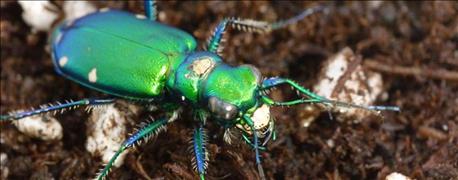December 13, 2016

Neonicotinoids, the most widely used class of insecticides, significantly reduce populations of predatory insects as much as 10% to 20% when used as seed coatings. That’s the bottom line of recent Penn State University research.
That surprising finding challenges the previously held belief that neonicotinoid seed coatings have little to no effect on predatory insect populations. The work found that neonicotinoids reduce populations of insect predators as much as broadcasted pyrethroid applications.
 BENEFICIAL BUG: Study found that neonicotinoid coatings on seed corn and soybeans reduce populations of predatory insects, like this tiger beetle, as much as broadcasted pyrethroids. (Photo by Ian Grettenberger/UC, Davis)
BENEFICIAL BUG: Study found that neonicotinoid coatings on seed corn and soybeans reduce populations of predatory insects, like this tiger beetle, as much as broadcasted pyrethroids. (Photo by Ian Grettenberger/UC, Davis)
"Predatory insects contribute billions of dollars a year to agriculture through the elimination of crop pest insects," notes Margaret Douglas, a research entomologist. "We’ve found that neonicotinoid seed coatings reduce populations of these natural enemies 10% to 20%. Surprisingly, this effect was about the same as that associated with broadcast applications of pyrethroids."
Neonicotinoid use has risen dramatically in recent years, adds John Tooker, Penn State Extension entomologist, especially for large-acreage crop species like corn, soybeans and cotton. The insecticide is most often applied to seeds as a prophylactic coating. When the seeds are planted, the insecticide enters the soil where some is taken up by plant roots. Then it’s absorbed systemically through the plant, protecting young seedlings from insect pests.
How they discovered it
The team used a statistical method, called meta-analysis, to combine the results of more than 1,000 observations from 20 field studies across North America and Europe that tested the effects of seed-applied neonicotinoids on predatory insects.
"Unfortunately, the available literature is difficult to interpret," acknowledges Tooker. "Some studies show little influence of neonicotinoids presented as seed treatments on arthropod predators common in crop fields. Others show a strong influence. By using a meta-analysis approach, we were able to combine the results of many studies to quantitatively reveal the overall influence on predator populations."
The insecticide acted more strongly on insect predators than on spiders. In other words, spiders appeared to be less susceptible to neonicotinoids than insects.
"This result suggests that neonicotinoids are reducing populations of natural enemies at least partly through their toxic effects rather than simply by reducing the availability of their crop pest foods," adds Douglas.
IPM and management implications?
Several governments have restricted neonicotinoids use out of concern for their possible effects on pollinators, says Douglas. But this raises two questions:
-What will farmers do without these products?
-If they switch to broadcasted pyrethroids, will those products be better or worse for predatory insects?
The Penn State work doesn’t address the pollinator issue. But it suggests that predatory insects are affected similarly by seed-applied neonicotinoids and broadcast pyrethroids.
The answer to the problem, notes Tooker, lies in the application of Integrated Pest Management — a combination of control techniques which may or may not include targeted use of insecticides. Substantial research supports the value of IPM for pest control. And he concludes: "It’s the best chance we have of conserving beneficial insect species while maintaining productivity in our agricultural systems."
LaJeunesse is a freelance science writer for Penn State.
You May Also Like




